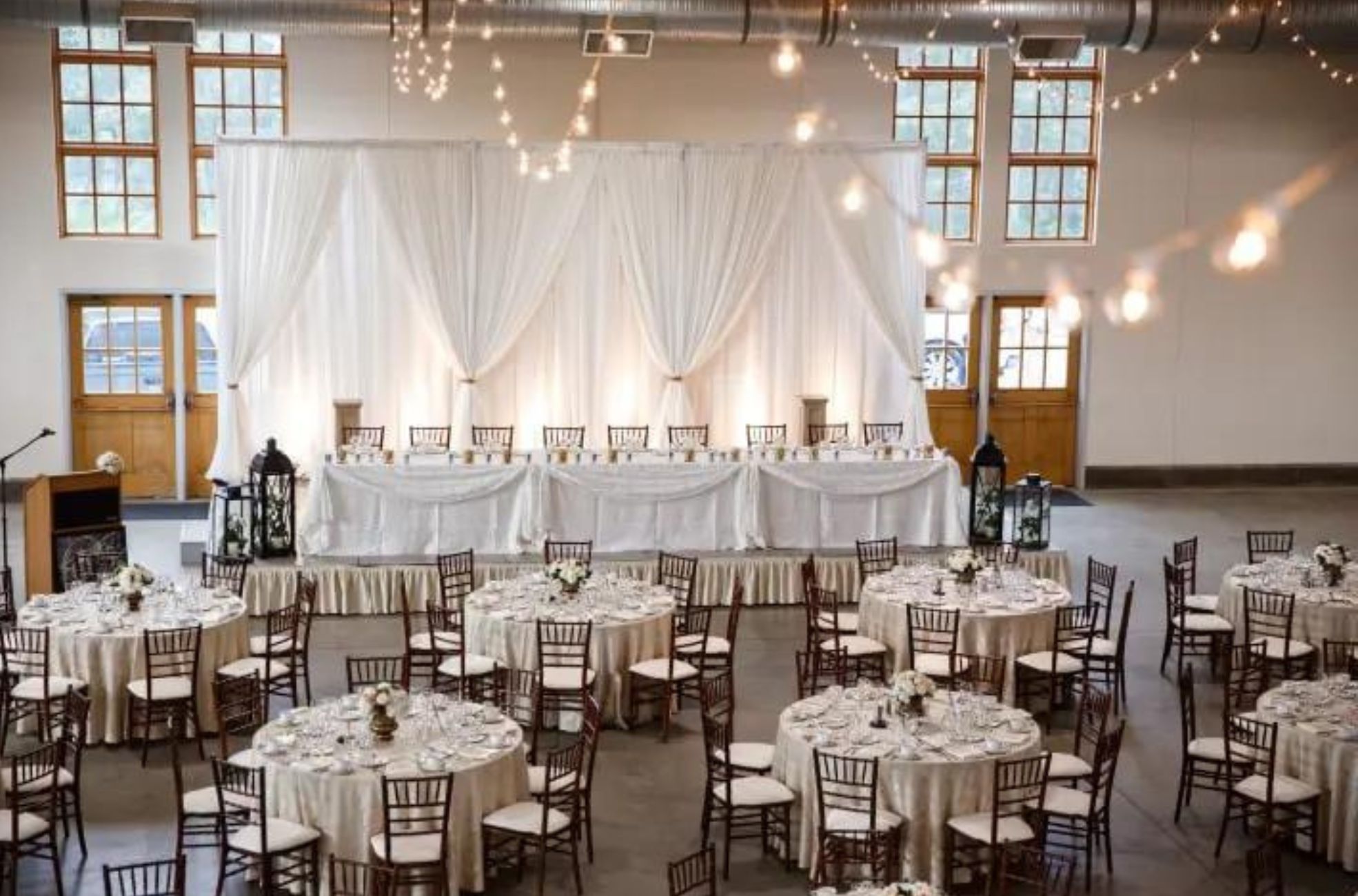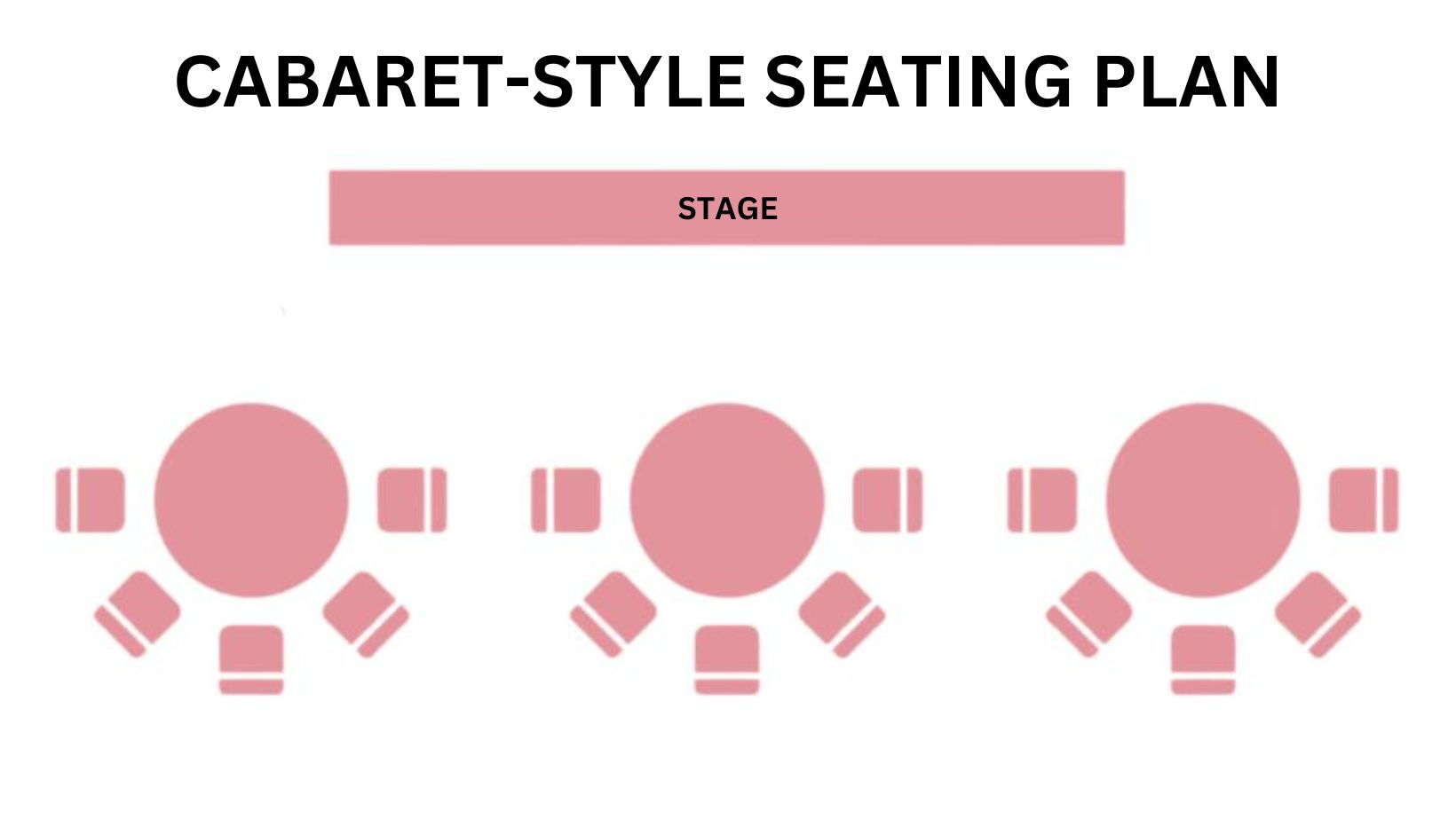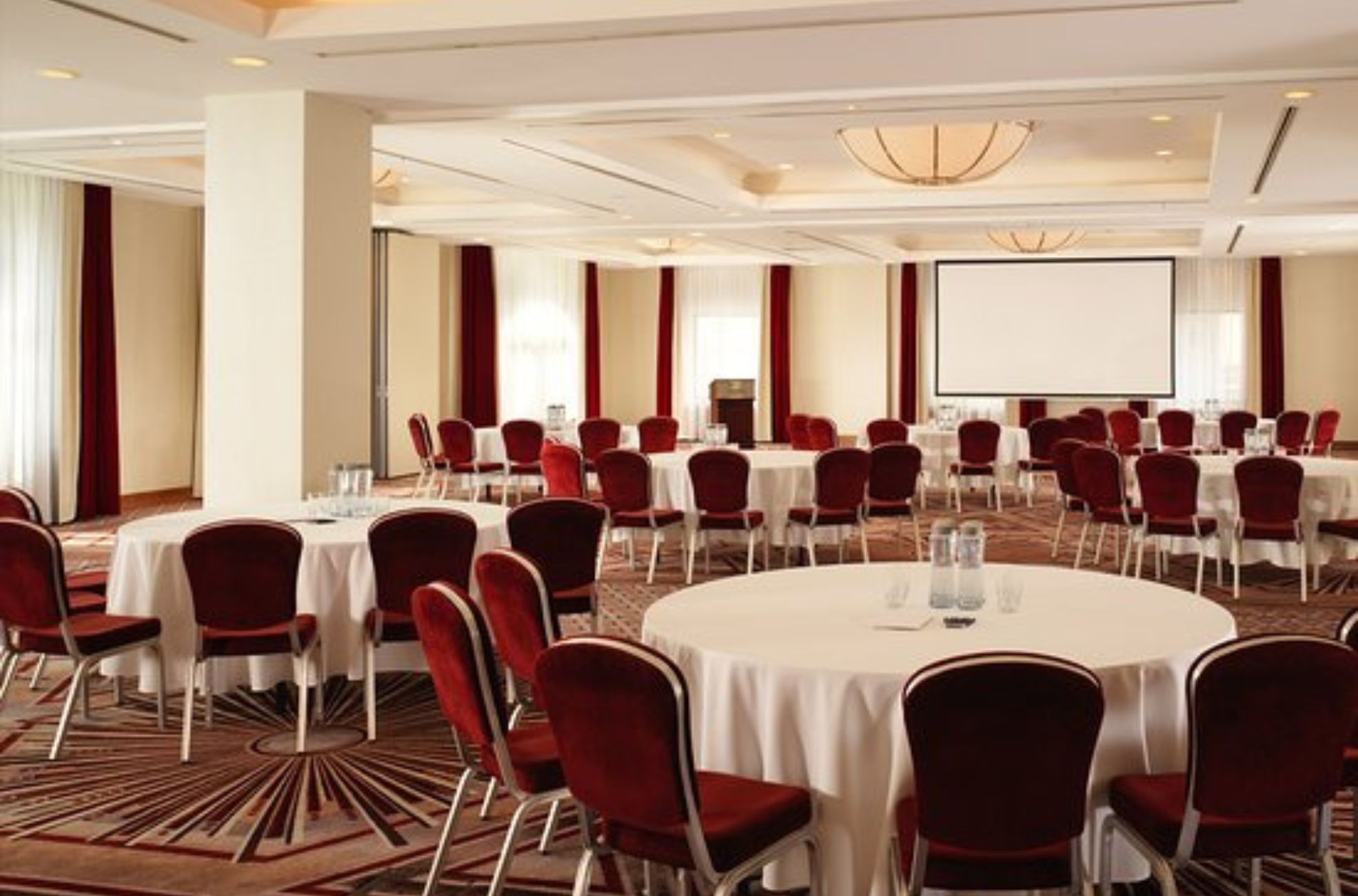Cabaret-style seating is an interactive and flexible arrangement that can transform any event into an engaging experience. This seating style facilitates social interaction while maintaining focus on a stage or presentation area. With its historical roots in the lively cabarets of Paris, the modern incarnation of cabaret-style seating is perfect for events where participation and visibility are essential. It combines the formality of assigned seating with the freedom of casual mingling, making it adaptable to various occasions.
Join us as we delve into the essentials of cabaret-style seating, from its unique features and benefits to practical tips for arranging a successful event with this dynamic setup. Whether you’re planning a corporate seminar, a gala dinner, a wedding reception, or a collaborative workshop, understanding how to effectively arrange cabaret-style seating can enhance your guests’ experience and ensure the success of your event.
What Is Cabaret-Style Seating?
Cabaret-style seating is a unique arrangement for various events, including presentations, galas, award ceremonies, dinners, and training sessions. It’s similar to banquet seating but with a twist. Typically, a cabaret seating style also involves round tables with chairs arranged around two-thirds of the table, intentionally leaving an open end.
This setup aims to direct your attention towards a focal point, like a stage or presenter, and it’s great for encouraging social interaction and collaborative work among guests. You might find seats assigned by a team or ticket group, or you might have the freedom to pick your spot, adding to the flexibility of this seating style.
Historical Origins of Cabaret Seating
The concept of cabaret seating dates back to the 12th century, with the term ‘cabaret’ coming from the Picard or Walloon words ‘cambelt’ or ‘ambrette,’ which means a small room. The word first popped up in France in 1275. By the late 15th century, cabarets were a staple in Paris, offering a different vibe from taverns by serving food on cloth-covered tables and charging by the plate instead of by the mug.
In the 17th century, taverns and cabarets started to stand apart. Taverns stuck to wine sales and later to serving roast meats. Cabarets, though, became known as social spots for intellectuals, artists, and friends, serving as a place for creative and social exchange.
Key Features of Cabaret Seating Arrangements
When setting up cabaret-style seating, there are several key features to keep in mind to ensure your event goes off without a hitch. This banquet-style seating can take up quite a bit of room, which is something to think about when hosting many people. Visibility is key, so you’ll want to make sure everyone can see the stage or presentation area clearly.
The layout usually starts with a long front row, with the following rows staggered to keep everyone’s view unblocked. Screens might be placed at the front and, if needed, on the sides of the room for presentations. To keep the view clear, table centerpieces should be low, and chairs should face the front.
It’s important to discourage guests from moving chairs and blocking the open end of the table. A contrasting table runner can help show which side should stay clear. You can hang decorations above the tables to set the mood without getting in the way of anyone’s view.
Risers can be used to lift the audience or speakers, making sure everyone can see. Clear aisleways are a must for easy access and leaving the room. Keeping the chair color and style consistent can also pull the whole look together.
High-top tables can be set up in cabaret-style for a more laid-back vibe by leaving the front part chair-free.
Benefits of Cabaret Setup for Events
Choosing a cabaret setup for the floor plan of your event has several perks. It lets guests focus on a central point while still being able to chat and work together. The arrangement’s versatility is perfect for both assigned seating and casual mingling, fitting all sorts of event styles.
When done right, the setup isn’t just practical; it looks good, too. It ensures everyone can see the stage or screen, creating an environment great for getting involved and participating. The layout can accommodate multimedia presentations and live broadcasts with smart screen and equipment placement.
You can add decorations that match your event’s theme without messing with sightlines. Risers can improve visibility even more. A well-thought-out layout means guests can move around easily, getting in and out without disrupting the event.

Designing a Cabaret-Style Layout
Calculating Room Capacity and Space Requirements
Determining the room’s capacity is the first step in planning your event. This layout requires more square footage per person than traditional arrangements due to the space left open at each table. To optimize your venue seating capacity, calculate the number of tables and chairs required based on the number of attendees, ensuring ample circulation space.
Table Selection and Placement Strategies
Selecting appropriate tables and their placement is essential for a successful cabaret layout. Round or oval tables are typically preferred, seating 6-8 guests each. To enhance sightlines, tables should be arranged in a staggered pattern, with cocktail tables in the subsequent rows offset from the ones in front.
The front-row event seating should be spaced generously, with the following rows positioned to optimize visibility. Ensuring chairs are oriented towards the stage before guests arrive can ensure clarity.
High-top tables at the front without chairs can provide additional options for speakers or attendees who prefer to stand.
Aisle Management for Guest Comfort
Aisle management is crucial for maintaining comfort and facilitating movement. Aisles should be clearly defined and sufficiently wide to allow easy passage. Consistency in chair style and color contributes to a cohesive aesthetic and can help minimize visual clutter.
To deter attendees from repositioning chairs and disrupting the intended layout, chairs should be pre-arranged to face the stage. Table runners can be used to subtly indicate the seating chart on the side that should remain unoccupied.
Seating Arrangements and Variations
Classic Cabaret-Style Configuration
This configuration is ideal for events that combine presentations with opportunities for attendees to converse and work together. The open segment of the table arrangement enhances focus on the stage or speaker.
To optimize the audience’s line of sight, each row of tables should be offset from the one in front. Additional screens can be strategically positioned to ensure that presentation materials are visible to all attendees.
Alternative Layouts and Customizations
Event organizers can tailor the seating to the nature of their event, whether it’s by grouping attendees or fostering a dynamic environment for networking. Pre-setting the orientation of chairs can maintain the intended design and minimize disruptions.
Adapting to the venue’s limitations, such as structural pillars, may involve creative adjustments like splitting the arrangement or incorporating high-top tables in certain areas. Screens placed strategically around obstructions can maintain the visibility of the stage or presentation area.
Consistency in décor, such as chair and tablecloth design, contributes to a harmonious setting. Refreshments served in individual carafes can serve a dual purpose as functional and aesthetic table elements.
Integrating Dance Floors or Performance Spaces
Incorporating a dance floor or space for performances requires careful planning to preserve sight-lines and facilitate movement.
Elevating either the audience or the presenters on risers can address the challenges of a flat seating arrangement. Decorative elements can be suspended above the tables to enhance the ambiance without impeding the view.
A foldable screen for events with live acts can offer a discreet area for performers to ready themselves, contributing to seamless transitions throughout the program.

Event Planning with Cabaret Seating
Selecting Suitable Events for Cabaret Seating
This seating style is well-suited for various gatherings that blend attentive audience behavior with interactive opportunities. It’s particularly effective for occasions that involve both listening and participation, such as seminars or collaborative workshops.
Facilitating Interaction and Audience Engagement
Event planners can enhance interaction by strategically assigning seating to foster team unity or by allowing open seating to promote networking. Staggering tables in a way that each is positioned between those in the previous row optimizes space and maintains clear sightlines.
Accessibility Considerations
Accessibility is a priority in cabaret seating arrangements, necessitating ample space for movement and unobstructed views for all attendees. Pre-arranging chairs to face the stage and using low centerpieces helps maintain clear sightlines. Risers can elevate the audience or presenters, enhancing visibility.
Consistent chair styles and colors contribute to a unified aesthetic. Strategic screen placement can preserve visibility when dealing with venue features like pillars. Table runners can delineate the non-seating side, and utilizing airspace for decor keeps aisles clear.
High-top tables can be placed at strategic points for events requiring a stage presence to serve as speaker stations. Creative table decor, such as bold tablecloths and seat bows, can complement the open table design. Centerpieces that are both functional and decorative, like individual carafes, can enhance guest convenience and the event’s ambiance.
Practical Tips and Best Practices
To enhance the cabaret-style setup, consider placing additional screens around the room to circumvent any structural obstacles that impede views. These centerpieces should be in harmony with the event’s theme and the venue’s aesthetic.
Before the event begins, ensure chairs are pre-arranged to face the focal point, which could be accentuated with a distinctive podium or specialized presentation equipment. A statement table runner can subtly guide guests to the preferred seating area, adding a touch of elegance without obstructing sightlines.
Consider employing the airspace for lightweight decorative elements that contribute to the theme without creating visual barriers. If the venue has a flat layout, risers can be used to elevate either the audience or the presenters, ensuring compliance with safety standards, including railings where necessary.
Maintain orderly aisleways, incorporating a central aisle and additional aisles as needed for larger venues to facilitate smooth ingress and egress. Consistency in furniture design and color is essential for a cohesive look. Selecting distinctive chair designs or colors for events with speakers can make them stand out. High-top tables can be strategically placed to offer speakers a space to engage with attendees post-presentation.
Ensuring Visibility for All Attendees
Careful planning of the layout is crucial to ensure that every attendee has an unobstructed view. Screens are particularly useful in larger venues to ensure all visual content is accessible. Subtle cues like contrasting table runners can guide guests to the best viewing positions while keeping the decor above table level, ensuring an immersive atmosphere without visual interference.
Décor and Thematic Elements
The décor should enhance the event’s ambiance while maintaining practicality. Short centerpieces that resonate with the event’s theme and color scheme contribute to the atmosphere. A statement table runner serves a dual purpose as decoration and a subtle seating guide.
Employing the airspace for thematic decor elements can add a dynamic dimension to the event’s aesthetic. Always confirm with the venue regarding permissible decorations, particularly for ceiling-hung items.
Common Mistakes to Avoid in Cabaret-Style Setups
Avoiding common pitfalls in cabaret-style seating is essential for a successful event. Ensuring that the layout promotes good sightlines and that aisleways are kept clear is vital. A central aisle is indispensable for visibility, and an additional aisle may be necessary for larger venues to support fluid movement. Consistency in furniture choice is key to a unified appearance. Thoughtful placement of high-top tables can enhance visibility and provide a casual space for speakers. Avoiding these mistakes will contribute to a memorable and enjoyable cabaret-style event.
Perfecting Your Cabaret Seating
Crafting the ideal cabaret-style seating is an art that combines practicality with aesthetics. The magic of this arrangement is in its ability to foster engagement and comfort. By placing your guests’ needs at the forefront of your planning, from ensuring every line of sight is clear to selecting decor that complements without cluttering, you set the stage for an event and an experience.
Remember, the key lies in the details: strategic table placements, consistent design elements, and clever use of space all create an inviting atmosphere. Whether your event is a lively team workshop or an elegant gala, cabaret-style seating offers a versatile canvas to make your occasion unforgettable. Keep these tips in mind, and watch as the space you’ve arranged comes alive with the buzz of conversation and the glow of shared moments.







